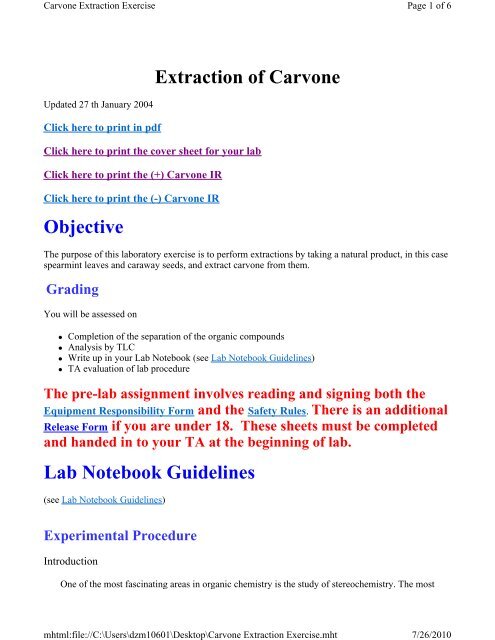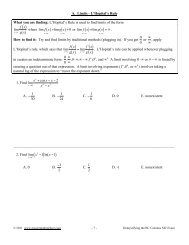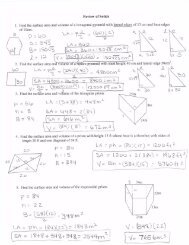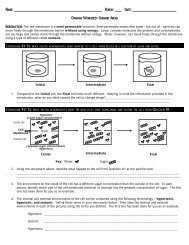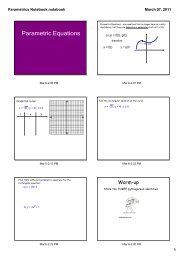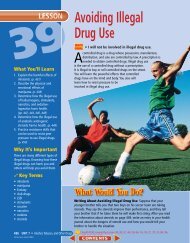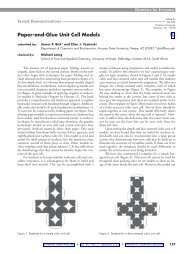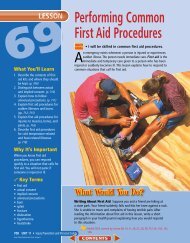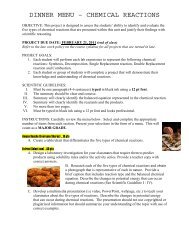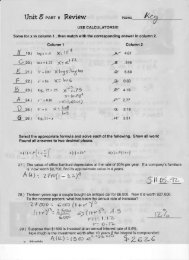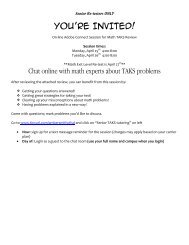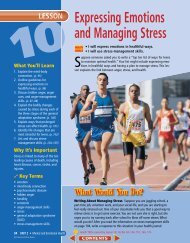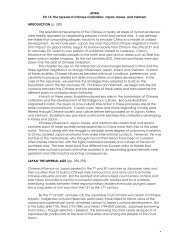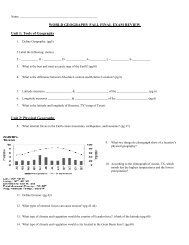Extraction of Carvone
Extraction of Carvone
Extraction of Carvone
Create successful ePaper yourself
Turn your PDF publications into a flip-book with our unique Google optimized e-Paper software.
<strong>Carvone</strong> <strong>Extraction</strong> Exercise<br />
Updated 27 th January 2004<br />
Click here to print in pdf<br />
<strong>Extraction</strong> <strong>of</strong> <strong>Carvone</strong><br />
Click here to print the cover sheet for your lab<br />
Click here to print the (+) <strong>Carvone</strong> IR<br />
Click here to print the (-) <strong>Carvone</strong> IR<br />
Objective<br />
The purpose <strong>of</strong> this laboratory exercise is to perform extractions by taking a natural product, in this case<br />
spearmint leaves and caraway seeds, and extract carvone from them.<br />
Grading<br />
You will be assessed on<br />
Completion <strong>of</strong> the separation <strong>of</strong> the organic compounds<br />
Analysis by TLC<br />
Write up in your Lab Notebook (see Lab Notebook Guidelines)<br />
TA evaluation <strong>of</strong> lab procedure<br />
The pre-lab assignment involves reading and signing both the<br />
Equipment Responsibility Form and the Safety Rules. There is an additional<br />
Release Form if you are under 18. These sheets must be completed<br />
and handed in to your TA at the beginning <strong>of</strong> lab.<br />
Lab Notebook Guidelines<br />
(see Lab Notebook Guidelines)<br />
Experimental Procedure<br />
Introduction<br />
Page 1 <strong>of</strong> 6<br />
One <strong>of</strong> the most fascinating areas in organic chemistry is the study <strong>of</strong> stereochemistry. The most<br />
mhtml:file://C:\Users\dzm10601\Desktop\<strong>Carvone</strong> <strong>Extraction</strong> Exercise.mht<br />
7/26/2010
<strong>Carvone</strong> <strong>Extraction</strong> Exercise<br />
complicated part <strong>of</strong> most syntheses is to ensure that your product has the appropriate stereochemistry,<br />
and an enormous amount <strong>of</strong> work is expended by chemists to try to ensure better stereochemical control.<br />
Interestingly, living organisms have no problem producing stereochemically pure products. While it is<br />
difficult to make an enantiomerically pure compound in the lab, plants and animals do it constantly with<br />
no error. Living organisms are also much more sensitive to stereochemical differences than many<br />
laboratory tests. Using most techniques, two enantiomers behave exactly the same: they will have the<br />
same melting point, boiling point, and density, and will react identically with achiral chemicals. The<br />
only way to distinguish between different enantiomers in the laboratory is to measure their optical<br />
activity or treat them with other enantiomerically pure chemicals. Living organisms, on the other hand,<br />
are excellent at distinguishing between enantiomers. The nose, for example, is one <strong>of</strong> the most sensitive<br />
tools for distinguishing some enantiomers--two different enantiomers can smell completely different<br />
even though they behave the same as one another in many other tests.<br />
In this lab you will study two naturally produced enantiomers, (-)-carvone and (+)-carvone. Both <strong>of</strong><br />
these chemicals are edible in small quantities and are used as flavoring oils in industry. They have the<br />
exact same molecular structure, except that they are mirror images <strong>of</strong> one another.<br />
One <strong>of</strong> these enantiomers comes from caraway seeds and the other from spearmint leaves. These<br />
compounds are responsible for the distinctive smells <strong>of</strong> the plants, and you can easily determine which<br />
enantiomer is derived from which plant by its smell.<br />
You will extract carvone from both caraway seeds and spearmint leaves by soaking the plant matter in<br />
the proper solvent, and then you will use thin layer chromatography (TLC) and IR to compare the<br />
compounds you extract. The extraction is based on the fact that carvone is very soluble in methylene<br />
chloride and in methanol. Therefore, soaking seeds or leaves in either <strong>of</strong> these will cause it to leach out<br />
<strong>of</strong> the plant matter and into the solvent. The reason we do not use the same solvent for both extractions<br />
is that methanol dissolves the carvone more readily but also dissolves many other substances. There are<br />
so many materials in caraway seeds that are soluble in methanol that using this solvent would result in a<br />
highly contaminated sample. In spearmint leaves fewer contaminants are extracted into the methanol, so<br />
it is an ideal solvent for this extraction. Methylene chloride does not dissolve carvone as well, but it is an<br />
effective solvent for the extraction <strong>of</strong> carvone from caraway seeds, where it is abundant.<br />
Experimental<br />
NOTE: All TLC plates that have glass backing go into the sharps container. They may not be<br />
sharp when you use them but odds are the glass will end up that way.<br />
The technique that will be used to analyze your extracts is explained in the following section.<br />
THIN LAYER CHROMOTOGRAPHY (TLC)<br />
Page 2 <strong>of</strong> 6<br />
TLC is one <strong>of</strong> the most commonly used techniques in chemistry. It allows a chemist to accurately and<br />
rapidly analyze very small quantities <strong>of</strong> material. In this experiment you will use TLC to identify and<br />
also to check the purity.<br />
mhtml:file://C:\Users\dzm10601\Desktop\<strong>Carvone</strong> <strong>Extraction</strong> Exercise.mht<br />
7/26/2010
<strong>Carvone</strong> <strong>Extraction</strong> Exercise<br />
Page 3 <strong>of</strong> 6<br />
TLC plates are either glass or aluminum that has been coated with a very thin layer <strong>of</strong> silica. See text.<br />
The polar silica is strongly attracted to polar materials, and any polar material on the plate will tend to<br />
stick to it. When you place a small spot <strong>of</strong> material at the bottom <strong>of</strong> the plate, it will be carried up the<br />
plate by the solvent as capillary action proceeds. The most polar components <strong>of</strong> the sample will be very<br />
attracted to the stationary silica gel and not move very far up the plate. The least polar materials will<br />
have no attraction at all for the silica and will dissolve in the solvent well, thus moving up the plate at<br />
the same speed as the solvent itself. As time goes on, the compounds within the sample will become<br />
separated on the plate according to polarity. The most polar molecules will be stuck at the bottom while<br />
the least polar will flow quickly to the top.<br />
A TLC plate is prepared as follows. Take a plate and mark two lines on it. Place one line approximately<br />
1-2 cm from the bottom and one 1-2 from the top. You will spot the sample on the lower line. When the<br />
TLC plate is being developed the solvent will run up the plate. You will remove the plate when the<br />
solvent reaches the second line. In about one minute the solvent will evaporate and you will be able to<br />
check your sample under UV light or stain the plate to determine which compounds appeared. After<br />
development the plate will look something like the following diagram.<br />
TLC spots are identified by their Rf value, which is the ratio <strong>of</strong> the distances the spots ran to the<br />
distance the solvent itself ran. Thus the Rf is calculated by dividing the distance the spot ran by the<br />
distance the solvent ran. You can see that the spots on the plate shown above have Rf values <strong>of</strong> 0.25,<br />
0.72, and 0.87.<br />
It can be useful to run several samples on the same TLC plate to easily compare the components <strong>of</strong> one<br />
sample with the components <strong>of</strong> another. If the same molecule is contained in two different samples,<br />
when you run the samples together on the same plate this molecule will run the same distance for both<br />
samples and you will see two spots right next to each other. The size and intensity <strong>of</strong> the spots are<br />
indicative <strong>of</strong> the amount <strong>of</strong> material, so you can see which sample contains more <strong>of</strong> the material. In this<br />
lab you will be given two samples <strong>of</strong> carvone (one + and one -) that were bought from a chemical<br />
company. You will run these on the same TLC plate as you plant material extracts in order to determine<br />
whether you actually extracted carvone and how pure this extract is.<br />
Remember to always use pencil when marking a TLC plate. Pen ink will run up the plate along with<br />
the solvent and render the plate unreadable.<br />
mhtml:file://C:\Users\dzm10601\Desktop\<strong>Carvone</strong> <strong>Extraction</strong> Exercise.mht<br />
7/26/2010
<strong>Carvone</strong> <strong>Extraction</strong> Exercise<br />
Page 4 <strong>of</strong> 6<br />
Procedure<br />
1) Measure 2 g <strong>of</strong> crushed caraway seeks into the 30 mL beaker and add 10 mL <strong>of</strong> ether. Ether is chosen<br />
as a solvent because the carvone is soluble in ether. Cover with aluminum foil to prevent evaporation<br />
and allow to stand for 15-30 minutes.<br />
2) Measure 2 g <strong>of</strong> spearmint leaves into the 50 mL beaker and add 10 mL <strong>of</strong> ether. Again, cover with<br />
aluminum foil and allow to stand for 15-30 minutes.<br />
The different containers have no effect on the extraction. It simply allows you to do two extractions<br />
simultaneously without duplicating your glassware.<br />
3) Once the seeds have soaked for the appropriate time, use a Hirsch funnel to filter the caraway seed<br />
solution. This is done by placing a piece <strong>of</strong> filter paper in the funnel, assembling the Hirsch funnel as<br />
diagrammed below, and starting the suction so that a vacuum builds up in the filter flask. Pre-wet the<br />
filter paper with ether, then pipette the liquid from the extraction into the funnel and collect the liquid in<br />
the receiving flask. When you have filtered the caraway seed solution transfer the filtrate to the cleaned<br />
30 mL beaker and wash out the receiving flask with acetone.<br />
4) Repeat step 3 with the spearmint leaves using a clean pre-wetted piece <strong>of</strong> filter paper. Transfer this<br />
filtrate into the cleaned 50 mL flask.<br />
5) Obtain a TLC plate that contains an indicator (metal or glass backed only) and draw a pencil line<br />
about 1 cm from the bottom on the side coated with silica. Draw a parallel line 1 cm from the top. On<br />
the lower line draw four small lines evenly spaced along this line to indicate where you will place your<br />
samples.<br />
mhtml:file://C:\Users\dzm10601\Desktop\<strong>Carvone</strong> <strong>Extraction</strong> Exercise.mht<br />
7/26/2010
<strong>Carvone</strong> <strong>Extraction</strong> Exercise<br />
Label the lines "+" (for (+)-carvone), "-" (for (-)-carvone), "c" (for caraway extract), and "s" (for<br />
spearmint extract).<br />
See you TA if you haven't already about preparing a spotter in lieu <strong>of</strong> using a capillary tube.<br />
6) Dip the tip <strong>of</strong> a spotter (or capillary tube) into your caraway extract and quickly dab this tip onto the<br />
line where it is labeled c. You may find it beneficial to do this under UV light to see how much sample<br />
you are placing and how large <strong>of</strong> a spot you are creating. You should see a very small amount <strong>of</strong> the<br />
caraway extract soak into the plate. For the two extracts it is a good idea to spot multiple times (or to<br />
concentrate your sample) as the amount <strong>of</strong> carvone in the sample is small. Simply spot, let the solvent<br />
evaporate (leaving the sample on the plate) and spot again at the same location.<br />
7) Repeat this procedure for the spearmint extract<br />
8) Now do the same thing with the diluted (+) and (-) carvone standards. These are more highly<br />
concentrated than your extracts so make sure to just barely touch the plate with the spotter.<br />
Page 5 <strong>of</strong> 6<br />
9) When you have spotted all four <strong>of</strong> your samples, obtain about 5 mL <strong>of</strong> 10% ethyl acetate in hexane<br />
in you 250 mL beaker. Place the beaker on your bench top.<br />
10) Make sure that the solvent is initially below the line you used to spot the plate. Place you TLC<br />
gently into the beaker. You will see capillary action begin immediately as solvent runs up the plate.<br />
11) Cover the beaker to prevent evaporation (a watchglass or aluminum foil is appropriate). After a few<br />
minutes the solvent will reach the upper line. Remove the plate and allow the solvent to evaporate.<br />
12) Let the plate dry and then take it to the UV light. The spot <strong>of</strong> carvone will be visible in the UV<br />
light. Mark the spot by holding a UV light to it and circling all the spots you see in pencil. You should<br />
see a carvone spot in all four samples, though it may be larger in some than in others. Note any<br />
differences you see. Be sure to record the plate in your notebook to the correct scale.<br />
13) You can also stain the plates with a p-anisaldehyde stain. This stain turns carvone a reddish brow<br />
color and turns most other compounds blue, so it will be easy for you to identify the carvone spot.<br />
Using forceps, dip your plate into the anisaldehyde solution. Wipe <strong>of</strong>f the glass back <strong>of</strong> the TLC plate<br />
with a paper towel, and then use a heat gun the heat the plate. You will see a pinkish color develop over<br />
mhtml:file://C:\Users\dzm10601\Desktop\<strong>Carvone</strong> <strong>Extraction</strong> Exercise.mht<br />
7/26/2010
<strong>Carvone</strong> <strong>Extraction</strong> Exercise<br />
the whole TLC plate and blue or brow spots where the material ran. Be sure not to overheat the plate or<br />
it may crack. Once done, check your TLC plate with your TA.<br />
Draw a picture <strong>of</strong> the stained plates in your notebook and determine the Rf values. Can you find the redbrown<br />
carvone spot on all four samples? Can you tell by the spots which enantiomer is contained in<br />
spearmint and which is in caraways seeds?<br />
14) Go see the IR demonstration and receive a copy <strong>of</strong> the IR for both pure carvone samples if you<br />
haven't already. Do the two enantiomers have distinctly different peaks? Could you tell the difference<br />
between enantiomers based on the IR spectra?<br />
15) Smell the pure samples <strong>of</strong> + and - carvone and then smell some unused caraway and spearmint<br />
leaves. Can you tell by smell which <strong>of</strong> the enantiomers is from spearmint and which is from caraway?<br />
Post Lab Questions<br />
Page 6 <strong>of</strong> 6<br />
1. In this lab you used three methods to attempt to distinguish between enantiomers. Outside <strong>of</strong> these<br />
three, there is a common method used for distinguishing between enantiomers or determining how<br />
much <strong>of</strong> one enantiomer is present in excess. What is this method?<br />
2. Which methods that you used in this lab (IR, TLC, smell) proved to be effective in distinguishing<br />
enantiomers?<br />
3. Separating enantiomers from a mixture is difficult but possible. Since these compounds have the<br />
same melting point, boiling point, and density as well as other properties, there is not much that<br />
allows a chemist to separate the enantiomers. Think <strong>of</strong> or find a method that will allow a chemist<br />
to separate enantiomers.<br />
4. What functional groups do you observe in the IR Spectrum?<br />
mhtml:file://C:\Users\dzm10601\Desktop\<strong>Carvone</strong> <strong>Extraction</strong> Exercise.mht<br />
7/26/2010


